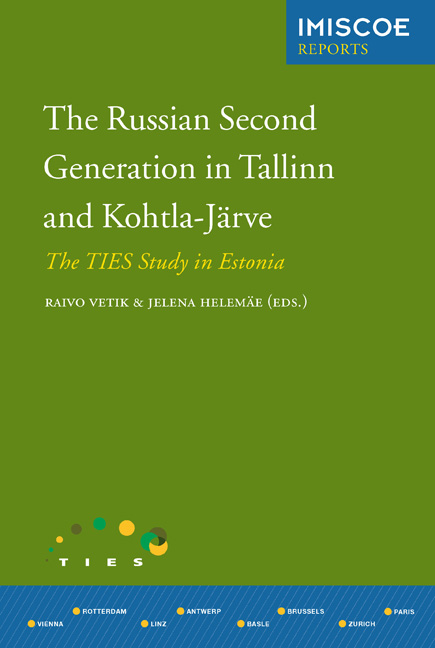Book contents
- Fronmatter
- Contents
- Preface
- List of Tables, Figures and Chapter Appendices
- 1 Introduction
- 2 Migration Patterns
- 3 Integration Policies
- 4 Ethnic Inequalities in Education
- 5 Explaining Different Returns from Human Capital in the labour Market
- 6 Income Inequality
- 7 Housing Conditions Andneighbourhood Satisfaction
- 8 Contact and Crisis in Interethnic Relations
- 9 Gender role Attitudes
- 10 Sense of Belonging to Estonia
- 11 Conclusions
- Appendix
- List of Contributors
- Other IMISCOE Titles
5 - Explaining Different Returns from Human Capital in the labour Market
Published online by Cambridge University Press: 20 January 2021
- Fronmatter
- Contents
- Preface
- List of Tables, Figures and Chapter Appendices
- 1 Introduction
- 2 Migration Patterns
- 3 Integration Policies
- 4 Ethnic Inequalities in Education
- 5 Explaining Different Returns from Human Capital in the labour Market
- 6 Income Inequality
- 7 Housing Conditions Andneighbourhood Satisfaction
- 8 Contact and Crisis in Interethnic Relations
- 9 Gender role Attitudes
- 10 Sense of Belonging to Estonia
- 11 Conclusions
- Appendix
- List of Contributors
- Other IMISCOE Titles
Summary
Introduction
Ethnic inequalities characterise most labour markets in Europe. The extent of ethnic inequality depends on the specific societal context, as well as the characteristics of ethnic groups. In many European countries, the disadvantaged labour market position of first-generation immigrants relates to their insufficient human capital, foreign qualifications and work experience (Heath & Cheung 2007). However, the children of immigrants attain their education in the country of destination and most likely acquire similar aspirations for economic success as natives (Portes & Zhou 1993). Studies have shown that there is labour market assimilation across generations. Although the second generation probably experiences ethnic disadvantages in the labour market, it is to a lesser extent than the first generation (Heath 2007). On the other hand, intellectual, material and social resources tend to accumulate and can lead to ever greater advantages across generations, while the lack of resources also accumulate into frequently overwhelming difficulties (Portes, Fernandez-Kelley & Haller 2005). The second generation's entry into the labour market has increasingly highlighted the question of how to explain the different labour market successes of ethnic groups. The research has called attention to different mechanisms of labour market functioning that may mediate ethnic disadvantage such as discrimination, the role of networks, structural constraints and the importance of country-specific human capital.
The integration of Russian youth – who largely belong among second- generation immigrants – into the labour market is one of the key issues in Estonian society. However, in the context of employment, it is important to note that there are some significant differences between first-generation immigrants in Estonia and other Western countries. First, at the time of their migration, the Estonian economy was integrated into the Soviet Union's state-controlled economic system. Firstgeneration immigrants did not have to compete with natives, as is often the case in the Western European labour market. Also significant is the fact that the first generation of Russians had a similar level of education as ethnic Estonians. Furthermore, after arriving in Estonia they were usually employed in professional or skilled occupations and they did not experience any status change due to immigration. However, the societal system changed and a market economy was introduced after Estonia regained its independence in 1991.
- Type
- Chapter
- Information
- The Russian Second Generation in Tallinn and Kohtla-JärveThe TIES Study in Estonia, pp. 93 - 118Publisher: Amsterdam University PressPrint publication year: 2012



